Hey, and welcome to the sixth update of the Brave New Teams newsletter.

What happened?
During the last couple of months, we focused on the following:
Thanks for reading Brave New Teams! Subscribe for free to receive new posts and support my work.
- Optimizing the user flow of the MVP and creating wireframes for the web application
- Tuning the deep reinforcement learning model for the team assembly
- Applying psychometrics to personality assessments
Three of the four core model ingredients of SuperScript are finalized; 1) the problem definition, 2) the required skill mix, and 3) the psychometric assessment. In addition, an algorithm for the team assembly mechanism has been implemented. Still, it is slow, and now we are working on an optimization based on deep reinforcement learning to replace it.

User flow for MVP: We worked with Cinnamon, a specialist agency for user design and software development, on the user flow, the core product features, and the sitemap of the application, as well as on wireframes.
Deep reinforcement learning: We continue to improve the deep reinforcement learning method, using hyperparameter tuning to achieve results close to the optimal baseline.
Psychometrics: We worked with Alyssa Birnbaum, an organizational psychologist, to develop a tailor-made survey to help us understand personal tendencies relevant to teamwork. The answers will be used to create optimal teams considering not just hard but also soft skills.
The survey contains 40 questions and takes about 5 minutes to complete. The surveyed categories are 1) adaptability, 2) resistance, 3) curiosity, 4) cooperation, and 5) achievement striving.
- Adaptability: Tendency to be flexible and ready to actively change or adjust in new, changing, or ambiguous work environments.
- Resilience: The ability to bounce back and cope with adversity, risk, uncertainty, conflict, change, or increased responsibility.
- Curiosity: Self-initiative behavior related to seeking information and experiences for their own sake.
- Cooperation: Willingness (and preference) to work with others to complete interdependent tasks, even when not required.
- Achievement Striving: Holding high standards, aiming to achieve excellence.
Why is it important?
Brilliant individuals are not enough to succeed. Equally important though frequently underestimated, is achieving the right blend of talent, personality, and motivation.
“You can hire a group of highly skilled individuals, but if they don’t operate as a cohesive team, will they drive success? Effective teams develop better strategies, perform more consistently, and increase the confidence of stakeholders. But a team can’t be effective in a culture that lacks collaboration, trust, and inclusion—and that starts at the top.” (From “How to build a team”, McKinsey & Company)
Of course, a team’s optimal degree of diversity is not the same for every problem. Our working assumption is that more innovative (and “new”) problems require more cognitive diversity, all else equal.
The results from the psychometric assessment of the individual workers will allow us to select the “right” level of cognitive diversity for a given problem.
What’s next?
We will focus primarily on deep reinforcement learning to speed up the process and make the optimization fast. Another focus is on building the web application.
Endnote
Thank you for subscribing to Brave New Teams. There is a lot of talk about the future of work, the role of automation, and robots. But, as discussed in the post Automatic for the People, there is plenty of reason to remain optimistic about an augmented (and still human) future of knowledge work.
The next newsletter will discuss the main use cases and give an update on deep reinforcement learning.
Stay safe, and don’t lose the script.
Hey, and welcome to the fifth update of the Brave New Teams newsletter. This update is shorter than usual.

What happened?
During the last couple of months, we focused on the following:
- Optimizing the user flow of the MVP
- Running experiments with deep reinforcement learning for the team assembly
- Deploying skills tagging tool as an API
- Applying psychometrics to personality assessments
User flow for MVP: We worked with freelancers on the user flow of the application and the optimization of the user interface (UI) and user experience (UX). The focus was on the MVP and one of the challenges was which features to de-prioritize. We have agreed on a solid and logical user flow and have documented the MVP.
Deep reinforcement learning: To deal with the problem of a combinatorial explosion in a fast and efficient way, we want to move away from ‘brute-force’ optimization. We are currently experimenting with a deep reinforcement learning algorithm. The first sandbox results are very promising – the model learns quickly and delivers results that are way superior to the previously used basin-hopping optimizer.
Skills tagging: We have documented (using FastAPI) the skills tagging tool and have deployed it on an instance of AWS.
Psychometrics: For the team assembly mechanism to be truly effective, we consider not just the right mix of hard skills but also soft skills. We have started to work with a trained organizational psychologist on developing a psychometric test. This test must be non-intrusive but valid to describe personality characteristics that are relevant for teamwork.
Why is it important?
A good and carefully thought-through MVP user flow is the basis for both the design and the technical implementation of the application. Speeding up the team assembly mechanism with deep reinforcement techniques will improve the user experience further.
And the psychometric element is a cornerstone and a key differentiator of SuperScript:
Eric Schmidt, former chairman of Alphabet, said, “diversity is key to innovation”, and, “with a blend of different points of view, you’re much more likely to get the kind of innovation that pushes things forward.”
Teams and, in particular, diverse teams are smarter when it comes to solving complex problems. An optimal mix of mind, experiences, gender, ethnicities, age, workstyle, and very importantly, pluralism, a tolerance for non-conformist views and divergent thinking will increase so-called cognitive diversity and lead to superior outcomes — or, very much in the Aristotelian spirit, the whole is greater than the sum of its parts.
What’s next?
We will focus primarily on deep reinforcement learning to speed up the process and on the psychometric assessment.
Endnote
Thank you for subscribing to Brave New Teams. There is a lot of talk about the future of work, the role of automation, and robots. But, as discussed in the post Automatic for the People, there is plenty of reason to remain optimistic about an augmented (and still human) future of knowledge work.
The next newsletter will share SuperScript’s user flow for an MVP, discuss the main use cases and give an update on the deep reinforcement learning and the psychometrics approach.
Stay safe, and don’t lose the script.
Hey, and welcome to the fourth update of the Brave New Teams newsletter.
Forget this world and all its troubles and if possible its multitudinous Charlatans – everything in short but the Enchantress of Numbers.

Ada Lovelace was an English mathematician and writer, chiefly known for her work on Charles Babbage’s proposed mechanical general-purpose computer, the Analytical Engine. She was the first to recognize that the machine had applications beyond pure calculation. She published the first algorithm intended to be carried out by such a machine. As a result, she is often regarded as the first computer programmer and the founder of scientific computing.
What happened?
During March, a lot of work went into improving the NLP-powered skills tagging and the team assembly algorithm. Those are the two key elements of the SuperScript value proposition (boxes 1 and 3 in the diagram below).

Team assembly model
We improved the agent-based model and added more visual comparisons. In the chart below, you see the impact on Return on Investment (ROI) of moving from a random team assembly mechanism (red line) to optimized versions of team assembly. The green line represents an optimal team assembly mechanism with a flexible start date (i.e., an option to wait for the right team members to become available) and no hard budgetary constraint (i.e., higher-skilled and thus more “expensive” talent can be added to the team). You can see that the ROI of the optimal strategy is more than twice as high as for the poor (“random”) strategy.

The agent-based model (ABM) is deployed as a Streamlit app to make it easy to run simulations and analyze data in your web browser (it works well on large screens and iPad, less so on a mobile phone). You can play around with the tool and change parameters yourselves.
Skills tagging tool
We use Natural Language Processing (NLP) to generate the relevant skills from a user-defined problem description. The skills are sourced from a proprietary skills hierarchy we have developed.
The skills tagging is done through a 3-stage process:
- The user enters a description of the tasks that need to be completed for the project. The description is in bullet point format with one task per bullet point.
- Skill categories are presented to the user, and the user confirms/selects the ones that are applicable to their project.
- Skills within each skills category selected in step 2 are presented to the user, and the user confirms/selects the skills that are applicable to their project. The skills presented in this step are organized by category and subcategory.
You can try out the prototype for skills tagging in your browser.
Two embedding models are used to search and rank categories and skills based on cosine similarity. When identifying categories relevant to a project, the category embedding model is used to generate embedding for a line of the project tasks description, and each of those embeddings is compared to every project category embedding using cosine similarity. The relevance level of a category to a project description is taken to be the highest cosine similarity between any line of the project description and any category. The same process is used to rank skills except using embeddings generated using a different model that is specialized for skills.
We employed various embedding models that were trained using transfer learning, starting with a pre-trained model and using a small dataset of tagged project descriptions to fine-tune the model. The ‘SentenceTransformers’ library was used, which is built on top of the Hugging Face library.
Why is it important?
Having working prototypes for the two key elements of SuperScript’s value proposition, the team assembly model and the skills tagging tool, is critical and a major milestone.
What’s next?
Now that the two key analytical pieces of SuperScript work, we will continue to make them better (more robust, faster, and hence “scalable”).
A critical part of this improvement effort is the introduction of Reinforcement Learning. Reinforcement Learning (RL) is “is a type of machine learning technique that enables an agent to learn in an interactive environment by trial and error using feedback from its own actions and experiences.” In the case of reinforcement learning, the goal is to find a suitable action model that would maximize the total cumulative reward of the agent. The figure below illustrates the action-reward feedback loop of a generic RL model.

We have high hopes that RL can make the team assembly mechanism better (i.e., it converges faster to the global optimum). Most common applications of RL include resource management problems like job scheduling in compute clusters, which is similar in nature to the type of ‘logistics problem’ SuperScript is trying to solve.
In addition to improving the models, a focus, however, for the coming weeks is on connecting the two models and making them talk to one another. This is a technical piece of work but also one where the user flow, the interface, and the user experience must be thought through carefully and be designed.
On a side note: You may recall that we have launched a game (see here) in early 2022. The reception is way below expectations and we will be promoting the game over the coming weeks and months.
… one more thing
We promised to give an update on the Blockchain experiment. As I am sure you are aware, there is a lot of hype these days around web3, DAOs, and NFTs with a corresponding impact on the price of domain expertise. We, therefore, decided to go a bit slower about the Blockchain experiment that originally planned.
Endnote
Thank you for subscribing to Brave New Teams. There is a lot of talk about the future of work, the role of automation, and robots. But, as discussed in the post Automatic for the People, there is plenty of reason to remain optimistic about an augmented (and still human) future of knowledge work.
The next newsletter will introduce SuperScript’s user flow for an MVP, discuss the main use cases and give an update on the RL-approach for team assembly, the NLP-powered skills tagging, and their (technical) combination.
Stay safe, and don’t lose the script.Like this post
Hey, and welcome to the third update of the Brave New Teams newsletter.
Nothing takes place in the world whose meaning is not that of some maximum or minimum.
Leonhard Euler, 1744 in De Curvis Elasticis

Leonhard Euler was a Swiss mathematician, physicist, astronomer, geographer, logician, and engineer who made significant and influential discoveries in many branches of mathematics, such as infinitesimal calculus and graph theory. Euler was one of the most eminent mathematicians of the 18th century and is one of the greatest in history. He grew up in Riehen, a village near Basel, and he spent most of his adult life in Saint Petersburg, Russia, and in Berlin, then the capital of Prussia.
Euler is the father of graph theory, which helped him solve the problem of the ‘Seven Bridges of Königsberg’ and which is the basis for today’s network analysis (here is more on the story of networks). And for those of you interested in what Leonhard Euler’s followers did with the foundation he laid, here is a gentle introduction to Graph Neural Networks.
A quick update from SuperScript
January provided for an exciting start to the new year as we released the application for the agent-based model and a game to illustrate the power of algorithmic team composition. In addition, we developed the NLP-powered skills classification tool and the associated skills hierarchy.
Launching the agent-based model for teamwork
The agent-based model (ABM) is deployed as a Streamlit app to make it easy to run simulations and analyze data in your web browser (it works well on large screens and iPad, less so on a mobile phone).
Run the model! (in your browser)
Launching the game
The game’s objective is to compose teams of five (out of nine) to solve problems (that’s 126 possible combinations to assemble the team). The idea is to illustrate the superiority of an algorithm (a “robot”) to form teams. The value created by the machine is usually about twice as high as that of a human team assembler. So, how close can you get to “robot mode”?
We released the game in public beta in early January. Since then, the game has been played over 260 times. Thank you for all your feedback and suggestions. We have implemented some improvements (e.g., we increased the time you have to pick your team from 5 to 10 seconds) and added more explanations.
Run the game! (in your browser)
NLP-powered skills classification
We use Natural Language Processing (NLP) to generate the relevant skills from a user-defined problem description. The NLP model needs a skills taxonomy as an input. Quite surprisingly, no good skills hierarchies were available. We, therefore, built a three-level skills hierarchy from scratch that “almost” meets the MESE principle (mutually exclusive and collectively exhaustive). The individual skills are primarily sourced from EMSI.
We employed various embedding models that were trained using transfer learning, starting with a pre-trained model and using a small dataset of tagged project descriptions to fine-tune the model. The ‘SentenceTransformers’ library was used, which is built on top of the Hugging Face library.
We expect to share a link to a prototype of the tool (deployed as an API) in one of the upcoming newsletters.
Status
The purpose of SuperScript remains unchanged. It is to build optimal teams to solve complex problems. The optimization algorithm – step 3 – has been developed (part of the ABM). The optimization step assumes that problems are well defined and that the required skill mix and the worker skill portfolios are known. To create the inputs for the optimizer, we built the missing puzzle pieces, namely steps 1 and 2.
The diagram below illustrates the high-level model setup of SuperScript. Step 3, the optimization algorithm is developed (and will later be enhanced with reinforcement learning to make it run faster and deliver solutions that converge faster to the global optimum). Step 2 is about finding the optimal skill mix for a given portfolio. To do this, pattern recognition techniques are employed, i.e., required skills of past projects are used to predict the needed skill mix for the current project. Step 1 is about the classification of the problems and about understanding their (deep) structure.

Road to the MVP (aka the roadmap)
Now that prototypes exist for both the NLP-powered skills classification model and the agent-based model (ABM, with algorithms to compose teams optimally), the focus is now on integrating the two across a logical user flow. As a consequence, the priority for the next few months until summer 2022 is the creation of a holistic user flow that combines NLP and ABM (or, in other words, the focus is on the ‘arrows’ rather than the ‘boxes’) :
- Defining the MVP in terms of features, user flow (UI/UX), and technology stack (thereby combining the NLP and ABM models) to prepare for backend and front end development
- Applying fast reinforcement learning methods to complement (or replace) the optimization algorithm behind team assembly
- Improving the Streamlit application for the agent-based model to make its usage more intuitive (and self-explanatory)
- Updating pitch materials (narrative, deck, and video) to be prepared for pitching
- Participating in pitching competitions (and maybe in an accelerator program) to gather feedback (and maybe find a co-founder)
- Continuing (informal) discussions with representatives of medium-to-large-sized organizations to gather feedback
An experiment on the Blockchain
There’s a lot of talk (and hype!) these days about cryptocurrencies, the underlying infrastructure like Ethereum, and applications built on top of it. While many activities in this space are flawed and sometimes outright ridiculous, we believe that the technology and the fundamental beliefs are sound. (A good article and podcast on why cryptocurrencies are here to stay and how they will likely disrupt many areas of finance). Since a crypto-based future of work (article from Dror Poleg, his “hype-free crypto” course is highly recommended) is very close to SuperScript’s vision of a more open, less credentialist, and more meritocratic future (see here, here, and here), we plan to experiment with setting up a DAO.
What is a DAO? DAO stands for decentralized autonomous organization. It is an organization represented by rules encoded as a computer program that is transparent, controlled by the organization members, and not influenced by a central government. As the rules are embedded into the code, no managers are needed, thus removing any bureaucracy or hierarchy hurdles.
As part of this experiment, we want to achieve the following:
- Developing the game-theoretical aspects of collaboration and coordination as part of a reputation staking mechanism
- Improving our understanding of novel (less hierarchical) governance frameworks
- Testing (if and) how roles, teams, and hierarchies, as well as tasks, can be reconfigured dynamically in a version-control-inspired framework
The DAO, named MetaScript, should ultimately deliver a novel and open-source version for collaboration and coordination that seamlessly integrates with the other elements of SuperScript (see diagram below).

Endnote
Thank you for subscribing to Brave New Teams. There is a lot of talk about the future of work, the role of automation, and robots. But, as discussed in the post Automatic for the People, there is plenty of reason to remain optimistic about an augmented (and still human) future of knowledge work.
The next newsletter will discuss NLP-powered text classification, the Blockchain experiment and introduce SuperScript’s user flow for an MVP. And much more!
We are committed to building in public and will accompany the journey with newsletter updates in a (more or less) monthly rhythm.
Stay safe, and don’t lose the script.
Hey, and welcome to the second update of the Brave New Teams newsletter.
Like trains of cars on tracks of plush
I hear the level bee:
A jar across the flowers goes,
Their velvet masonry
Emily Dickinson, The Bee

Emily Elizabeth Dickinson (1830 – 1886) was an American poet. Little known during her life, she has since been regarded as one of the most important figures in American poetry. Dickinson lived much of her life in isolation. Considered an eccentric by locals, she developed a penchant for white clothing and was known for her reluctance to greet guests or, later in life, even to leave her bedroom. Dickinson never married, and most friendships between her and others depended entirely upon correspondence.
Against that backdrop and somewhat contradictory, we will talk about very social creatures. Bees thrive in a complex system of countless interactions and a very elaborate division of labor (more on this later).
A quick update from SuperScript
The work on SuperScript continues at an accelerated pace. The foundation has been laid, the product-market fit is confirmed and the core optimization algorithm has been developed. Now, the implementation phase starts. The plan for the next few months is as follows:
- Launch a simple game to (playfully) illustrate the problem of assembling teams
- Develop (and launch) a web-based tool to allow users to write NLP-powered project descriptions (more on this later)
- Develop (and launch) a web-based tool to illustrate the inner workings of the agent-based model for teamwork (more on this later)
- Apply reinforcement learning methods to complement (or replace) the optimization algorithm behind team assembly
- Participate in pitching competitions
- Continue discussions with medium-to-large-sized organizations
- Define the MVP in terms of features, user flow, and technology stack
The purpose of SuperScript remains unchanged. It is to build optimal teams to solve complex problems. The optimization algorithm has been developed and produces the expected results (due to the multidimensionality of the problem, the algorithm is computationally expensive and relatively slow for large numbers of workers). However, the optimization step assumes that problems are well defined and that the required skill mix and the worker skill portfolios are completely known. These assumptions are not realistic. Therefore, we have to go back and build the missing puzzle pieces, namely steps 1 and 2.
The diagram below illustrates the high-level model setup. of SuperScript Step 3, the optimization algorithm is developed (and will later be enhanced with reinforcement learning to make it run faster and deliver solutions that converge faster to the global optimum). Step 2 is about finding the optimal skill mix for a given portfolio. To do this, pattern recognition techniques are employed, i.e., required skills of past projects are used to predict the required skill mix for the current project. Step 1 is about the classification of the problems and about understanding their (deep) structure.

The focus now is on step 1, the problem definition. We use NLP techniques to classify and enrich the text a user is entering to describe the problem.
What is NLP? Natural Language Processing (NLP) is a field in machine learning with the ability of a computer to understand, analyze, manipulate, and potentially generate human language. (You can find more details and a handful of well-known applications here).
In our context, NLP techniques are applied to free text fields to impose a structure and classify the problem by predicting relevant skill tags. The objective is to build a web-based tool that allows users to write better and more complete project (problem) descriptions. The tool will also produce a set of relevant skills that are likely required to solve the problem at hand successfully. To get an idea about how NLP-powered text classification works, you can play with the so-called zero-shot classification (that is, the task of predicting a topic that the model has not been trained on) here. It feels a bit like magic!
Emergent properties of teamwork
Let’s go back to bees. Intuitively, a honeybee colony is the archetype of a complex system. Bees interact in non-trivial ways. This paper uses an agent-based approach to evaluate the impact of local actions at the bee level on the global system. A similar system and its emergent properties are illustrated in this NetLogo model (to start the model, define the parameters, press ‘setup’, and then ‘go”).
If the bee analogy doesn’t resonate with you, one complex system everybody is aware of these days is a virus. You may want to analyze the emergence of the virus in this model by changing population density and transmissibility parameters.
Very much in this spirit, a few years ago, BCG published a thought-provoking report arguing that we need to transition from ‘mechanical’ management to one based on ecological and biological principles.
So, what are agent-based models? According to Wikipedia: “An agent-based model (ABM) is a class of computational models for simulating the actions and interactions of autonomous agents (both individual or collective entities such as organizations or groups) with a view to assessing their effects on the system as a whole. It combines elements of game theory, complex systems, emergence, computational sociology, multi-agent systems, and evolutionary programming.”
We have built an ABM for teamwork. Workers are assembled in teams to work on projects based on their (hard and soft) skills and availability. Emergence is analyzed at the individual worker level (workload, skills, training), the project level (interaction, project outcomes) as well as at the organizational level (workload, skills, training).
The model is used to test several hypotheses, understand emergent properties, and generate simulated training data for the Machine Learning (reinforcement learning) prototype.
One interesting (and not entirely unexpected) emergent property of the ABM is ‘the-winner-takes-most-effect’. The higher the worker’s skill level (OVR), the more this worker is selected for (supposedly more interesting) project work. Participating in successful projects increases the skill level, and hence, those worker’s skill levels improve over time. Workers with very low skill levels get replaced more frequently, do seldomly get a chance to prove their worth (and to learn) in a project team, and are idle most of the time. For average-skill workers, training takes up a substantial portion of their workday, which, combined with project work, stabilizes the skill level over time.

One way to mitigate ‘the-winner-takes-most-effect’ is targeted training. With knowledge about predicted in-demand skills, low-to-medium-skilled workers suitable for an “upgrade” can be targeted for training. Such a well-designed training intervention, here applied to the bottom half of workers for two in-demand skills, can significantly impact the overall (average) project success probability (it increases from 30% before to 35% after the intervention).

For the data science aficionados among you, the model specification is available here and you may access the full code on the GitHub repository here.
Diversification matters most
According to Wikipedia, “modern portfolio theory (MPT), or mean-variance analysis, is a mathematical framework for assembling a portfolio of assets such that the expected return is maximized for a given level of risk. It is a formalization and extension of diversification in investing, the idea that owning different kinds of financial assets is less risky than owning only one type. Its key insight is that an asset’s risk and return should not be assessed by itself but by how it contributes to a portfolio’s overall risk and return. It uses the variance of asset prices as a proxy for risk.” The intuition is that diversification in a portfolio of financial assets pays off because it reduces the risk for the same level of expected return or increases the expected return for the same level of risk. Not owning a well-diversified portfolio is a stupid idea and a risk that is not rewarded.
The very same principle also applies to teams. Very much in the Aristotelian spirit of “the whole is greater than the sum of its parts”, diversification (or “diversity” in HR-speak) matters. A team consisting of only workers with similar educational backgrounds, age, sex, and personality is not well diversified. It is (for most intents and purposes) just not a good team to have. The optimal team composition exhibits different skills but also a level of cognitive diversity. And similarly to portfolio optimization, workers described by their skill characteristics can be assembled into an ideal team using optimization techniques.
Endnote
Thank you for subscribing to Brave New Teams. There is a lot of talk about the future of work, the role of automation, and robots. The dystopian future is one where robots don’t replace humans but where they are becoming our bosses. As discussed in the post Automatic for the People, there is plenty of reason to remain optimistic about an augmented (and still human) future of knowledge work.
In the next newsletter, we will talk more about the results of the agent-based model and NLP-powered text classification. And much more!
(Note that there will be a separate announcement for the launch of the team assembly game.)
Stay safe, and don’t lose the script.
Hey and welcome to the first update of the Brave New Teams newsletter.
You can’t depend on your eyes when your imagination is out of focus.
Mark Twain, A Connecticut Yankee in King Arthur’s Court

Mark Twain is widely considered “the father of American Literature”. His often sarcastic quotes and jokes have been told and retold. Over the course of his legendary life, Twain wrote more than a dozen novels plus countless short stories and essays and still found time to be a steamboat pilot, work as a miner, invent new products (including a board game and improvements to suspenders), hang out with famous scientists, and look after a house full of cats.
A quick update from SuperScript
The work on SuperScript began two years ago, in September 2018. Since then, extensive market research has been conducted, the problem was understood and validated as a real and relevant need for organizations, and a solution was defined. The feasibility of building the product has been assessed and work on the mechanism design, the coding of the prototype, and an agent-based simulation model is now far advanced.
First discussions with medium-to-large-sized organizations have been positive. Over the coming months, this interest will be further clarified with pilots and in non-binding letters of intent. SuperScript plans to release a functional prototype on its website to illustrate the mechanics of the tool with an engaging game-like experience. The purpose of the prototype is to illustrate use cases and to collect proof points. The prototype will represent teamwork as a social multiplayer game, will take the user through the ‘happy path’ with basic user interface design, will make the value-add of the tool tangible to a broad audience of corporate leaders, and at the same time collect simulated raw data to feed the machine learning algorithm.
Below is a high-level plan for the prototype:
- Development of an agent-based model in Python, using the Mesa framework [complete, more details and results in one of the coming posts]
- Introduction of optimization and Machine Learning algorithms in Python using the Gekko and PyTorch libraries to solve the team assembly (workforce assignment) problem, based on heuristic solution methods [in progress]
- Basic UX/UI and deployment via the Django framework on Heroku [in progress]
Upon completion and deployment of the prototype, SuperScript is looking for CHF 500’000 of seed funding. The funds will be used to develop the Minimum Viable Product (MVP), hire two teammates, and get ready to onboard pilot organizations. The MVP will consist of two separate web applications, one for the organization and one for the workers. As a complement to seed funding, agreements with organizations to frontload future fees and co-fund features of the application will be evaluated. The seed funding will enable SuperScript to continue its mission to help organizations and knowledge workers alike gain and maintain an emergent competitive advantage.
The paradox of choice
Putting together a team in a traditional organization with a hierarchical structure and rigid silos is easy and straightforward. As a project initiator, you merely look around and pick people you know well and who seem available. Ideally, those individuals report to you to avoid conflict and discussions with other managers. The search space is very limited, the team is average at best, as are the results. Choice is limited by design. If you increase the search space, the challenge of assembling a team becomes suddenly very hard. Simple combinatorics provides ample evidence of how intractable the problem of team formation is. There are over 2 million possible solutions to forming a team of five from a population of 50 people. Not all of those 2 million solutions will perform equally well, and a random selection will likely produce mediocre results. As McKinsey puts it: “Innovation is a team sport. For projects to succeed, they must be staffed with the right combination of talent.”

The critical question for optimal teamwork is how roles mesh together into a team that has complementary strengths. Advances in sports pave the way to more data-informed and more evidence-based decision making when it comes to team formation. Like in sports, data about individuals’ relevant characteristics are required, and profiles need to be assessed. Academics in complexity science have decomposed contributions to team performance in order to understand and improve successful collaboration.
Teamwork is a social multi-player game
Optimal teamwork is akin to a cooperative game. In many ways, SuperScript resembles an MMORPG, a massively multiplayer online role-playing game. Gamers are building and exchanging in immersive, distributed communities. Vital gameplay elements such as nudges to change behavior, predictive user guidance, frictionless entry, ludic loops, intermittent positive reinforcement, social approval and comparison, tribal mechanisms, micro, and macro challenges, and incentives are used as part of the design of the user interface and user experience to direct decision-making and to keep engagement high.
Endnote
Thank you for subscribing to Brave New Teams. As discussed in the article Automatic for the People, there is plenty of reason to be optimistic about an augmented future of knowledge work.
In the next newsletter, agent-based models and their application to emergent teamwork will be discussed. Another topic will be the use of Markowitz optimization techniques with heterogeneous workers, rather than asset classes. And much more!
Seven predictions for the future of knowledge work

“The main business of humanity is to do a good job of being human beings, […] not to serve as appendages to machines, institutions, and systems.”
― Kurt Vonnegut, Player Piano
Since the advent of computing technology, countless divergent futures have been prophesied by visionaries in various fields, from economists to science fiction authors. Many of these projected futures have at their core the question: how will computing change society, and what will be the role of humans in work when machines have largely solved the bulk of repetitive labor? In short, what kinds of work will still be available, and how will we facilitate such work? We find ourselves tasked with confronting these questions not as some far-off fantasy, but right here and now.
Over a century’s worth of dystopian fiction (and cranky economists) has bestowed upon us a library of insights into the kind of future that we want to avoid. But what of what we want? The time has come to look at the immediate and near-term reality of society with its current technological maturity, and turn our minds to the positive side of the script. How can we transition humanely and intelligently into a new era of work that accurately aligns with and benefits from the freedoms and opportunities granted by technology?
“Prediction is very difficult, especially about the future,” is a Danish proverb once attributed to Niels Bohr, who aptly iterated the phrase during his attempts to unravel the miracles of the atom. Making predictions is indeed complicated, and all the more so when the system we are trying to predict is a complex one.
The future of knowledge work is a complex system with many agents that interact with each other at small scales and then spontaneously self-organize to exhibit non-trivial global structures and behaviors at larger scales. It is — in a philosophical sense — a miracle of nature, and on a level such that any grand predictions on its course should necessarily be met with careful consideration.
With this humbling backdrop in mind, below are my seven predictions for how knowledge work changes over the coming five years:
1. Complex problems will dominate the workday, rather than routine tasks. Routine tasks that are characterized by mature process knowledge will be largely automated. Complex activities are more challenging. In these settings, workers must form teams with complementing skills and interact continuously to create and execute a course of action. The typical knowledge worker will be engaged in projects for about 80% of the time (up from today’s share of roughly 10%). Diverse teams are smarter when it comes to solving complex problems. An optimal mix of mind, experiences, gender, ethnicities, age, workstyle, and very importantly, pluralism, a tolerance for non-conformist views and divergent thinking will increase so-called cognitive diversity.
Today, most project teams are rather homogenous and not cognitively diverse. Without finding new ways to facilitate heterogenous teamwork, these teams will inevitably fail to realize their enhanced potential for achieving complex, creative, and non-routine work together.
2. Recruitment will focus on soft skills, rather than hard skills. For both hiring and team assembly, hard skills will no longer be the primary selection criterion. Soft skills and in particular those that an organization or team is currently lacking will be actively searched for and added. Teams with the right blend of talent, personality, and motivation are built for their purpose. As a consequence, impressive credentials alone will no longer be sufficient to get the job. The result will be diversity in the ultimate sense of the word.
Today, hiring and team selection are undermined by biases and poorly understood assumptions. Team members, while individually impressive, perform poorly together. Meanwhile, the search space when assembling a team is very narrow. Herein is where the need arises for a more all-embracing and holistic candidate search system that is able to identify opportunities for cohesive team action based on sound social principles, not mere human bias.
3. The talent pool will become global, rather than remain local. Talent is equally distributed and opportunities will soon be too. Technology is leveling the playing field and COVID-19 accelerated this development. A decentralized global workforce, the so-called ‘human cloud’, will grow further. This transition will be characterized by intense labor arbitrage in the digital services sector, analogous in scale and significance to the Industrial Revolution during the 18th and 19th centuries.
Today, hiring for a role is limited to the best candidates in an immediate area, or those, still fewer perhaps, who are able and willing to relocate within commuting distance to the office. The majority of the global talent pool is left out by default. But this will change, as it is even now changing before our eyes with rapid global adoption of remote working tools and technologies. Soon enough, the phrase, “Going to work,” might be rendered literally inaccurate; a relic of the past where we automatically perceived work itself as a physically distant activity, performed someplace else.
4. Teams will be distributed, rather than co-located. Technological and social developments will result in more agile and more decentralized organizational models. The Coasean case for large hierarchical, bureaucratic, and rigid organizations will be mostly gone. Talent will have more flexibility in how, when, where, and for whom it works.
Today, most organizations have big offices for a largely overqualified and underutilized workforce. They can afford to be vague about the skills they need and they generally treat internal resources as if they were free. As distressingly inefficient that this is, there is also an easy solution at hand: administering human capital in ways that most closely align with the fluid nature of distributed teamwork.
5. Organizations will become ‘talent-light’ and hire on-demand, rather than entertaining an underutilized workforce. More knowledge workers will have at-will contracts and work on multiple projects for multiple organizations concurrently. This availability of on-demand talent will make medium-to-large-sized organizations shrink their workforce and become more ‘talent-light’. They will tap into the on-demand talent and deploy it dynamically if, when, and where required.
Today, most organizations focus on in-person and synchronous meetings. Yet, if we are to enable meaningful knowledge work in a complex environment, there is an open and unfulfilled need to rethink communication strategies with a view to facilitating talent that can be hired and put to work at equal convenience to all parties.
6. Most communication will be in writing, rather than verbal. A strong preference for verbal and synchronous communication excludes large parts of the population from their participation in the knowledge economy. Moving to written communication will allow organizations to seamlessly work across time zones.
Today, most organizations are way out of their depth when it comes to managing workforce logistics, dynamically deploying talent, and building optimal teams. They will move away from a built-in expectation of synchronous communication (treating it as supplementary rather than essential to the communication process) in favor of an approach that encourages asynchronous communication at the core of team collaboration.
7. New algorithms will enable knowledge workers and organizations, rather than disable them. Software solutions will tackle the problem of workforce logistics and build optimal teams that are fit for purpose. Those approaches will employ data-driven optimization algorithms to support unbiased and evidence-based decisions. In a fast-paced world, organizational survival depends on matching the right people quickly and efficiently to today’s problems.
With the reward that large, even the most traditional and rigid organizations will change. This is why there is a need to start figuring out those algorithms now. Without sufficiently sophisticated and carefully created algorithmic engines, which are in agreement with everything outlined here, there will be little benefit gained from all the other advances in technology going forward.
I’m optimistic about the future of knowledge work. Technology will enable organizations and knowledge workers alike, to transition and become more humane and more inclusive. Human capital will become tangible on a global scale and knowledge work will be ‘automatic for the people’.
And please, challenge me! I’d love to read your suggestions for the shape of knowledge work. Please leave your comments here.
In a fast-paced world, organizational survival depends on matching the right people quickly and efficiently to today’s problem. Sadly projects beget projects in an endless cycle. Most fail! Outcomes fall below expectations, timelines become elastic, and budget overruns jeopardize financial success.
Striving to avoid poor outcomes, corporate leaders emphasize coordination and communication. This does not guarantee success. Equally important though frequently underestimated, is achieving the right blend of talent, personality, and motivation. Team selection is undermined by biases and poorly understood assumptions. Team members, while individually impressive, perform poorly together. Collaborative problem solving never emerges. Innovation is rare, and success is limited. The team fails to be more than the sum of its parts. At worst, it is less! Skills and talent, in addition to time and energy, are wasted.
Great teams are not born, great teams are made.
SuperScript solves these problems. SuperScript is a tool for corporate leaders to build project teams fit for their purpose. It finds the right people; with the right motivation, and brings them together in the right mixture of soft and hard skills to address today’s problem. SuperScript does this by employing a data-driven optimization algorithm that improves automatically with experience to engineer teams for success.
These teams exhibit cognitive diversity by design and create superior solutions to complex problems. SuperScript unlocks better use of in-house talent. Knowledge workers express their full potential through better collaboration. Over time truly productive networks flourish. Complex problems get solved faster, cheaper, and better, which translates into a sustainable competitive advantage. Human capital has become tangible!
Shifts in technology and in the ways people want to work are leading the charge into new-found paths. Emerging digital technologies such as machine learning and distributed ledger technology (DLT) are disrupting the workplace. Talent itself wants more flexibility in how, when, where, and for whom it works. Workers with the most in-demand skills are increasingly choosing to work remotely and on-demand.
Ubiquitous high-speed internet (more than 50% of the world is connected), widespread vaccination, and affordable access to high-quality training and education will increase participation and fuel the move to remote work arrangements on a global scale. Large companies like Amazon, SpaceX, and Facebook are investing heavily to create a space-based internet, which will eventually provide high-speed internet access for the remaining 50% of the world’s population.
In developed countries, the safety net is tied to traditional work arrangements. According to surveys, one of the main reasons for workers to still favor conventional full-time employment. The unbundling of the safety net from a traditional work arrangement, one of the last remaining puzzle pieces, is now gaining traction and will increase the supply of talent from developed countries.
As a consequence of Covid-19, a majority of knowledge workers have experimented with remote work. Large traditional organizations recognized that remote working works and will shift their work model towards it. As part of this change, organizations realize that they can access talent from anywhere and that the requirement for co-location is becoming mostly obsolete. While claims of the death of the office seem premature, the popularity of the option to work from anywhere will only continue to grow with lasting impact on the relationship between firms and their employees. There are signs this may not be a short-term phenomenon, but more of a permanent shift in favor of remote work even after a Covid-19 vaccine is in place. More than two-thirds (69%) of large US company CEOs plan to downsize their office space according to KPMG.
McKinsey describes “traditional” and “agile” organizations as follows:
The dominant “traditional” organization (designed primarily for stability in a factory-like environment) is a static, siloed, structural hierarchy — goals and decision rights flow down the hierarchy, with the most potent governance bodies at the top. It operates through linear planning and control to capture value for shareholders. The skeletal structure is strong, but often rigid and slow-moving.
In contrast, an agile organization (designed for both stability and dynamism) is a network of teams within a people-centered culture that operates in rapid learning and fast decision cycles that are enabled by technology. That is guided by a compelling shared purpose to co-create value for all stakeholders. Such an agile operating model can quickly and efficiently reconfigure strategy, structure, processes, people, and technology toward value-creating and value-protection opportunities. An agile organization thus adds velocity and adaptability to stability, creating a critical competitive advantage in volatile, uncertain, complex, and ambiguous conditions. Disruptive trends introduce organizational challenges brought by the “digital revolution”. These trends dramatically change how organizations and employees work. Indeed agile organizations are both stable and dynamic at the same time. They design stable backbone elements that evolve slowly and support dynamic capabilities that can adapt quickly to new challenges and opportunities. Agile organizations mobilize quickly, are nimble, empowered to act, and make it easy to move. In short, they respond like a living organism. When pressure is applied, the agile organization reacts by being more than just robust; performance improves as more pressure is exerted — the agile organization thus is anti-fragile.
Jamie Johnson defines knowledge workers as the “people who are developing new strategies and coming up with ideas for new products and services” and are “individuals with a high level of education and experience. The main focus of their job is to use and apply knowledge in a creative and innovative way.” She further describes their main characteristics as having “specialized knowledge of a subject, the ability to find and access new information, the ability to utilize new information, good communication skills, and a growth-motivated mindset.”
Peter Drucker first coined the term ‘knowledge worker’ in 1959 when he stated: “The most valuable asset of a 21st-century institution, whether business or non-business, will be its knowledge workers and their productivity.” Three years later, the famous consultant, author, and scholar stated that increasing the productivity of knowledge workers was “the most important contribution management needs to make in the 21st century.”
Despite advancements in technology (like AI, automation, robotics) that are supposedly going to wipe out jobs, knowledge workers continue to be the most prolific area of job growth in the modern economy. In 2020, it is estimated there are 300 million knowledge workers in the world. With technological and societal changes, this number will likely grow to above 500 million over the next ten years.
The World Economic Forum, in a study on the ‘digital enterprise’, defines the motivation of employees in the digital age as follows: “Employees will likely still want security, predictability, and status, but in different forms and in a different context: one of learning, impact, and purpose. Security becomes less about lifelong employment and more about lifelong employability, achieved through the constant acquisition of new and relevant skill sets. Employees are not giving up predictability, but their timelines are shortening, and their willingness to experiment in different roles and functions is growing. And employees still want status, to some extent, in fair compensation, benefits, and rewards for outperformance.”
An NPR/Marist poll finds that 1 in 5 jobs in America is held by a worker under contract. Within a decade, contractors and freelancers could make up half of the global workforce, thereby fundamentally changing the supply and demand dynamics for knowledge work in an increasingly growing, open, and borderless marketplace. Already today, according to the Remote Work Report, “about three-quarters of knowledge workers would be willing to quit a job that didn’t allow remote working for one that did.” The decentralized global workforce, the so-called Human Cloud, is growing.
This transition will be characterized by intense labor arbitrage in the digital services sector, analogous in scale and significance to the Industrial Revolution during the 18th and 19th centuries.
Three fundamental structures govern the nature of all economic activity: consumers, producers, and the way — the mediating infrastructure — in which value is exchanged between them. Traditional organizations, like firms, introduced a central authority and assumed a function of coordination and communication. With high transaction costs present, it was expedient to concentrate those functions within a central authority.
As a result of technological and societal changes, our economies and societies become more decentralized and flexible. With ever lower transaction costs, the Coasean case for large hierarchical, bureaucratic, and rigid organizations is mostly gone. Interestingly, the absence of transaction costs is the necessary precondition for Adam Smith’s “invisible hand”, the idea of trade and market exchange automatically channeling self-interest toward socially desirable ends. Digital and programmable money (smart contracts) based on Distributed Ledger Technology (DLT) like Facebook’s Libra, a cryptographically secure stable coin, will replace complex legal agreements and make the need for a bank account obsolete.
“To date, the gains and pains of globalization and automation have been felt mostly by the manufacturing sector. In the future, the gains and pains will be felt by […] service-sector jobs. That’s because digital technology is going to lower the third constraint to globalization as arbitrage: the cost of moving people around, or facilitating face-to-face interaction.
Service jobs have been shielded from globalization because they require people to be face-to-face, or at least near each other. For most services, you can’t put them into a container and ship them from China to New York. So global competition was deflected by the shield of high face-to-face costs.
Digital technology, however, is opening a pipeline for direct international wage competition. In other words, labor from countries such as Kenya, Nigeria, or the Philippines can come and work in G7 offices directly through telecommunications.”

